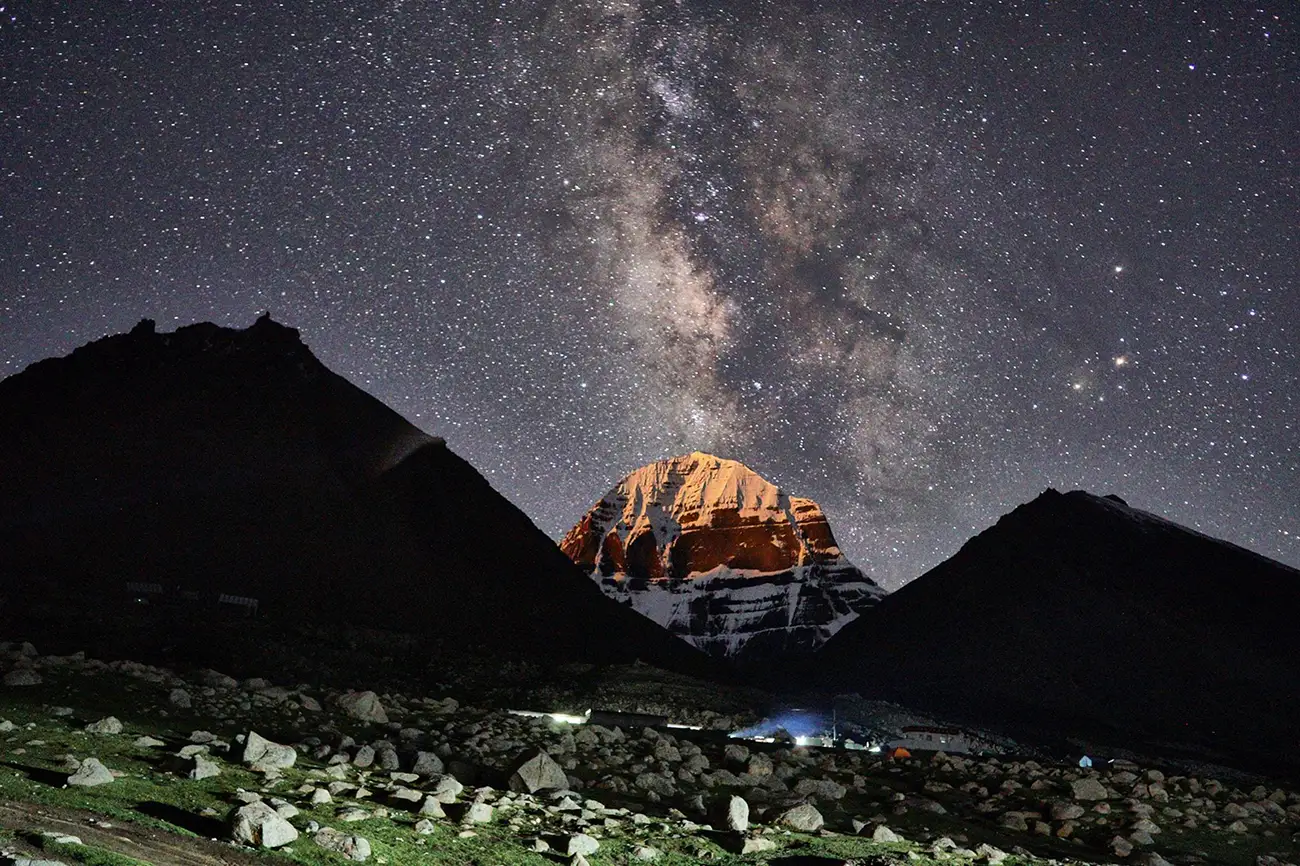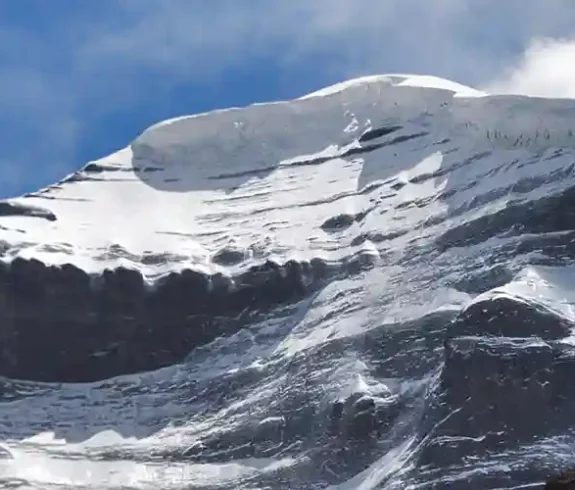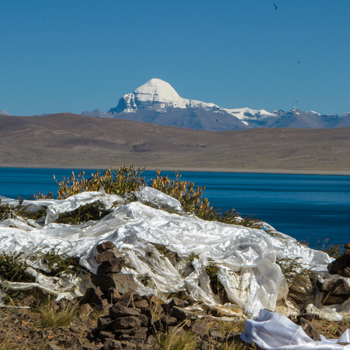Mount Kailash, a majestic peak nestled in the heart of the Tibetan Himalayas, holds profound spiritual significance for millions across the globe. It is not merely a geographical wonder but a sacred sanctuary revered by Hindus, Buddhists, Jains, and followers of the ancient Bon religion. While a Mount Kailash Climb to its summit remains forbidden due to its sacred status, the mountain attracts pilgrims and adventurers seeking spiritual enlightenment.
A Beacon of Faith for Multiple Religions
Hindus believe Mount Kailash is the dwelling place of Lord Shiva, the deity who destroys ignorance and embodies cosmic consciousness. Tibetan Buddhists believe it to be the dwelling of Demchog, a manifestation of supreme bliss. Jains revere it as where their first Tirthankara, Rishabhadeva, attained liberation. The Bon religion identifies it as the nine-story Swastika Mountain, a cosmic axis and the center of the universe.

A Unique Pyramidal Formation
The mountain’s most striking feature is its unique pyramid shape, with four distinct faces aligned almost perfectly with the cardinal directions. This symmetrical form adds to its mystique and reinforces its symbolism as a cosmic pillar connecting heaven and earth.
Mount Kailash: An Unclimbed Peak
- Unconquered Summit: Mount Kailash, with its summit soaring at 6,638 meters (21,778 feet), remains an unclimbed peak. Mountaineers have attempted to climb it, but they have yet to succeed.
- Sacredness: The Mountain’s sacredness and the harsh environmental conditions have deterred climbers. The local communities and religious authorities strictly prohibit any attempts to scale this holy peak.
- Kailash Expedition: While a Mount Kailash Climb may not be possible, the Kailash Kora, a 52-kilometer (32-mile) circumambulation around the mountain’s base, is a profoundly fulfilling spiritual tour for pilgrims from diverse backgrounds.
Why a Mount Kailash Climb is Forbidden: Religious and Cultural Significance
The prohibition of a Mount Kailash Climb stems from the mountain’s profound religious and cultural significance:
- Hinduism: Many believe that Mount Kailash is Lord Shiva’s abode, known as the destroyer and transformer of the universe. It is said to be the center of the world, a cosmic axis, and the source of four great rivers. Climbing it would be seen as a grave disrespect to the deity and the sacred space.
- Buddhism: Tibetan Buddhists revere Mount Kailash as the dwelling of Demchog, a wrathful deity representing supreme bliss. They also see it as a natural mandala representing Buddhist cosmology. Ascending the mountain would be considered blasphemy of this sacred symbol.
- Jainism: For Jains, Mount Kailash is Ashtapada, where the first Tirthankara, Rishabhadeva, attained liberation (moksha). Climbing it would violate this holy place of enlightenment.
- Bon: The ancient pre-Buddhist Bon religion of Tibet considers Mount Kailash the nine-story Swastika Mountain, a cosmic axis and the center of the universe. People would see any attempt to scale the mountain as a disturbance of this sacred power.
The Forbidden Ascent: A Profound Desecration
Due to its sacred status, climbing Kailash is considered a grave heresy. People believe that the mountain’s summit is the domain of the gods, and any human intrusion would disturb their celestial abode.
Many believe attempting a Mount Kailash Climb would bring bad luck or misfortune. Legends abound of climbers facing sudden illness, disorientation, or even death. While these stories may be apocryphal, they reinforce the taboo against mountain scaling.

The Sacred Circumambulation: The Kailash Kora
Rather than a Mount Kailash ascent, the spiritual practice associated with this sacred peak is the Kailash Kora. This 52-kilometer (32-mile) circumambulation around the mountain’s base is a pilgrimage of profound significance. People believe it purifies the soul, washes away sins, and accumulates spiritual merit.
The Kailash Kora is a challenging endeavor, often undertaken at high altitudes with varying weather conditions. Pilgrims may walk the entire route, taking three days on average, or some may choose to complete it in a single day. Each step is considered an act of devotion, and many pilgrims prostrate themselves along the path as a sign of reverence.
Mount Kailash: Challenges and Reasons Why a Mount Kailash Climb is Forbidden
Mount Kailash, a revered peak in the Tibetan Himalayas, presents formidable challenges and faces strict prohibitions that deter mountaineers from attempting a Mount Kailash Climb. These obstacles stem from religious beliefs, technical difficulties, environmental concerns, and official restrictions.
Religious and Cultural Taboos: A Revered Sanctuary
Mount Kailash isn’t just a mountain; it’s a deeply revered spiritual center for four major religions:
- Hinduism: Devotees revere Kailash as the dwelling of Lord Shiva, the destroyer of ignorance and symbol of cosmic consciousness. It also represents Mount Meru, the axis of the universe in Hindu cosmology.
- Buddhism: Tibetan Buddhists believe Kailash is the dwelling of Demchog (Chakrasamvara), who personifies supreme bliss. They also view it as a natural mandala symbolizing the Buddhist cosmos.
- Jainism: For Jains, Kailash is known as Mount Ashtapada, where their first Tirthankara, Rishabhadeva, attained liberation (moksha).
- Bon: Predating Buddhism in Tibet, the Bon religion regards Kailash as the nine-story Swastika Mountain, a cosmic axis and home to the sky goddess Sipaimen.
Technical Difficulties: A Formidable Challenge
Even without the religious taboos, Mount Kailash presents formidable challenges for climbers:
- Steep, Icy Slopes: The mountain’s near-vertical faces are covered in ice and snow, making the ascent treacherous.
- Unpredictable Weather: The weather in the region is notoriously unpredictable, with sudden blizzards and high winds posing severe risks to climbers.
- High Altitude: With a summit at 6,638 meters (21,778 feet), climbers would face extreme altitude sickness and other health hazards.
- Remote Location: The need for established climbing routes and rescue infrastructure increases the dangers of a Kailash expedition.
Environmental Concerns: Preserving a Fragile Ecosystem
The Himalayan ecosystem surrounding Mount Kailash is delicate and vulnerable to human impact. A Mount Kailash Climb could have devastating consequences:
- Erosion and Degradation: Increased foot traffic would accelerate erosion, damage vegetation, and disrupt wildlife habitats.
- Pollution: Waste disposal in such a remote environment is challenging, leading to potential pollution of water sources and soil.
- Disturbance of Wildlife: Climbers might disturb local animals’ natural routines and migration paths.
Official Restrictions: A Protected Peak
Recognizing the mountain’s religious significance and environmental vulnerability, the Chinese government has officially banned any attempts at Mount Kailash Climb. This decision aligns with the wishes of local communities and spiritual leaders who strive to protect the mountain’s sanctity. Permits for the Kailash Kora, the circumambulation around the mountain’s base, are readily available, but mountaineering activities are strictly prohibited.
Mount Kailash: A Summit Unconquered, a Mount Kailash Climb Attempted
Mount Kailash, a sacred peak shrouded in mystery, has long captivated adventurers and spiritual seekers alike. Despite numerous attempts throughout history, a successful climb to its summit still needs to be discovered.
Historical Accounts of Attempted Ascents
Milarepa: A legendary Tibetan Buddhist yogi, Milarepa, is said to have engaged in a mystical race to the summit with a Bon shaman. According to folklore, Milarepa ascended using a sunbeam, claiming victory and solidifying Mount Kailash as a sacred site for Buddhism. However, this account is steeped in mythology and needs historical verification.
Modern Expeditions: Dreams Dashed
- 1920s: In the 1920s, British explorers Hugh Ruttledge and R.C. Wilson conducted surveys of the mountain, but severe weather conditions thwarted their ambitions for Mount Kailash. After studying the north face, Ruttledge declared it “utterly unclimbable.”
- 1980s: In the 1980s, the Chinese government granted renowned mountaineer Reinhold Messner a permit for a Kailash expedition. However, he later abandoned the attempt, citing ethical concerns and the mountain’s spiritual significance.
An Unconquered Peak: A Testament to Respect
Mount Kailash still needs to be answered despite modern mountaineering technology and techniques advancements. The mountain’s formidable challenges and deep-seated respect for its religious significance have deterred climbers from attempting a summit.
Moreover, the Chinese government has officially banned any attempts to climb Mount Kailash, further solidifying its status as a sacred site protected from human intrusion.
A Spiritual Pilgrimage, Not a Mountaineering Challenge
While a Mount Kailash Climb may remain a distant dream, the mountain attracts countless pilgrims who undertake the Kailash Kora, a circumambulation around its base. People believe that this spiritual tour cleanses the soul and bestows blessings.
For those seeking adventure and spiritual connection, the Kailash Kora offers a fulfilling alternative to a Mount Kailash Climb. It allows individuals to experience the mountain’s raw beauty, cultural richness, and spiritual energy without violating its sanctity.
Legend of Milarepa and the Forbidden Ascent
Mount Kailash, a sacred peak in the Tibetan Himalayas, is steeped in legends and stories that reinforce its spiritual significance and discourage attempts at a Mount Kailash Climb. One such tale is the legendary ascent of Milarepa, a revered Tibetan Buddhist yogi whose story highlights the mountain’s mystical nature and the importance of spiritual practice over physical conquest.
Milarepa: A Yogi’s Ascent to Enlightenment
Milarepa, a renowned figure in Tibetan Buddhism, is said to have engaged in a supernatural race to the summit of Mount Kailash with a Bon shaman. While the Bon shaman employed magical powers, Milarepa relied on his spiritual practice and meditative abilities.
According to legend, Milarepa miraculously ascended the mountain on a sunbeam, leaving the shaman far behind. This victory solidified Mount Kailash as a sacred site for Buddhism and further entrenched the belief that the hill is a place of spiritual attainment, not physical conquest.
The Legend’s Impact: Reinforcing Sacredness
Milarepa’s legend is a powerful reminder of Mount Kailash’s spiritual significance. It emphasizes that the mountain is a realm for spiritual practice, where enlightenment is achieved through meditation and inner transformation, not by physical feats like climbing the hill.
The story also reinforces the cultural and religious taboos surrounding Mount Kailash’s ascent. It suggests that any attempt to conquer the mountain through physical means is futile and disregards its sacred nature.
The Kailash Expedition: A Pilgrimage, Not a Climb
The legend of Milarepa highlights the importance of the Kailash Kora, the traditional pilgrimage route that circumnavigates the mountain’s base. This spiritual tour is a more meaningful and respectful way to connect with the mountain’s energy and seek blessings.
The Kailash Kora: A Pilgrimage of Devotion
The Kailash Kora is a 52-kilometer (32-mile) trek encircles Mount Kailash. Hindus, Buddhists, Jains, and Bon followers undertake this pilgrimage, seeking spiritual blessings and purification. Pilgrims traditionally walk clockwise, mirroring the sun’s path, while some choose a more demanding counterclockwise route.
The trek typically takes three days, with pilgrims resting at guesthouses or campsites. The route winds through high-altitude landscapes, showcasing breathtaking glaciers, vibrant turquoise lakes, and valleys with fluttering prayer flags.
Religious Significance: A Path to Enlightenment
The Kailash Kora holds deep religious meaning for each faith:
- Hinduism: Pilgrims believe completing the Kora absolves them of a lifetime’s sins and draws them closer to Lord Shiva.
- Buddhism: Each step of the Kora symbolizes progress towards liberation from suffering, leading to enlightenment.
- Jainism: Jains view the Kora as a sacred tour that purifies the soul and accumulates good karma.
- Bon: For Bon followers, the Kora is a ritual to connect with the mountain’s spiritual energy and receive blessings from the deities dwelling within.
Spiritual Benefits: A Transformative Experience
Beyond its religious significance, the Kailash Kora offers a transformative experience with numerous spiritual benefits:
- Purification: The Kora cleanses the soul and washes away negative energies.
- Merit: Each step taken is an act of devotion, accumulating merit that brings positive outcomes in this life and beyond.
- Self-reflection: The challenging nature of the trek fosters introspection and self-discovery.
- Connection with Nature: The Kora immerses pilgrims in the Himalayas’ raw beauty, fostering a deep bond with nature and the divine.
A Reverent Alternative to a Mount Kailash Climb
The Kailash Kora is a respectful and spiritually enriching alternative to a traditional climb on Mount Kailash. It allows individuals to commune with the mountain’s sacred energy, participate in a time-honored tradition, and gain a profound understanding of the diverse religious beliefs associated with this extraordinary place.
Mount Kailash: An Unclimbed Peak, a Sacred Journey
Mount Kailash, a majestic peak in the Tibetan Himalayas, continues to captivate the world with its charisma. Despite numerous attempts, it has yet to reach its summit, and several factors contribute to this.
Why Mount Kailash Remains Unconquered
The reasons for the mountain’s untouched summit are multifaceted:
- Religious and Cultural Reverence: Hindus, Buddhists, Jains, and followers of the Bon religion deeply revere Mount Kailash. They consider a Mount Kailash Climb a grave desecration, violating their long-held beliefs and traditions. They view the mountain as a sacred pilgrimage site, not an obstacle to overcome.
- Formidable Technical Challenges: Mountaineers face daunting challenges attempting a Kailash expedition. Steep, icy slopes, unpredictable weather, high altitude, and a remote location make it a dangerous climb. Even seasoned climbers would encounter significant risks and logistical hurdles.
- Environmental Concerns: The fragile Himalayan ecosystem surrounding Mount Kailash is vulnerable to human impact. A Mount Kailash Climb could trigger long-term ecological damage, including erosion, pollution, and disruption of delicate wildlife habitats.
- Official Protection: Acknowledging the mountain’s religious significance and environmental fragility, the Chinese government has officially banned all attempts to climb Mount Kailash. This decision aligns with the wishes of local communities and spiritual leaders who strive to preserve the mountain’s sanctity.
Honoring Tradition and Beliefs
The sanctity of Mount Kailash transcends religious boundaries. It is a place of pilgrimage and spiritual devotion for millions worldwide. Respecting these beliefs and traditions is paramount, ensuring that the mountain’s spiritual significance endures for future generations.
Future Climbing Attempts: A Distant Dream
Given the strict religious and cultural taboos, the technical challenges, and the official restrictions, successful Mount Kailash ascents are highly unlikely. The mountain remains a protected sacred site, and any attempt to climb it would face strong opposition and potential legal consequences.
The True Allure of Mount Kailash
The true allure of Mount Kailash lies not in its conquest but in its mystery and spiritual significance. The Kailash Kora, a pilgrimage around the mountain’s base, offers a profound and fulfilling way to experience its beauty and connect with its sacred energy.


